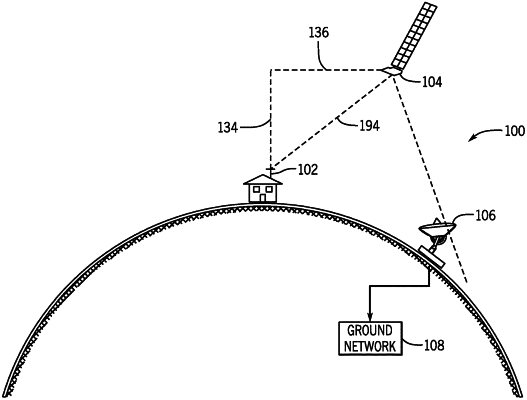| CPC H01Q 3/34 (2013.01) [H04B 7/195 (2013.01)] | 24 Claims |

|
1. A method of configuring an end point terminal for communication with a satellite constellation including a plurality of satellites in non-geosynchronous orbit (non-GEO), wherein at least a first plurality of satellites travel in a first orbital plane and a second plurality of satellites travel in a second orbital plane, wherein the first orbital plane intersects the second orbital plane at an intersection, the method comprising:
configuring the end point terminal having an Earth-based geographic location, the end point terminal having an antenna system defining a field of regard for communicating with the satellite constellation, wherein the field of regard is a limited field of regard, wherein the antenna system is configured for electronically steering along a first steering axis in first and second steering directions, wherein the antenna system is of configured for gimbaling in order to move the field of regard along a first gimbaling axis in first and second gimbaling directions;
orienting the field of regard in a first position, wherein the antenna system when the field of regard is at the first position is configured for communicating with at least one of the first plurality of satellites traveling within the first orbital plane;
as the first orbital plane precesses around a rotational axis of the Earth, gimbaling the antenna system to move the field of regard along the first gimbaling axis in the first gimbaling direction from the first position to a second position, wherein the antenna system when the field of regard is at the second position is configured for communicating with at least one satellite from the first plurality of satellites traveling in the first orbital plane and one satellite from the second plurality of satellites traveling in the second orbital plane, wherein the second position is at or near the intersection of the first and second orbital planes, and wherein the antenna system remains in communication with satellites from the first plurality of satellites traveling in the first orbital plane while the field of regard moves from the first position to the second position;
establishing communication between the antenna system and the one satellite from the second plurality of satellites traveling in the second orbital plane;
as the one satellite from the second plurality of satellites travels along the second orbital plane, gimbaling the antenna system to move the field of regard in the second gimbaling direction along the first gimbaling axis from the second position to a third position, wherein the one satellite from the second plurality of satellites remains in communication with the antenna system while the field of regard moves from the second position to the third position;
selecting the second position by determining, based on a model that predicts movement of satellites within the satellite constellation, a position wherein the antenna system is configured for communicating with at least one satellite from the first plurality of satellites and the one satellite from the second plurality of satellites, and the field of regard has less than a threshold amount of overlap with a GEO-belt interference zone, and selecting the second position by determining that a communication load of the one satellite from the second plurality of satellites is less than a threshold communication load when the field of regard is at the second position; and
predicting, based on the model, a first point in time at which the field of regard is positioned at the second position, and directing, at the first point in time, the antenna system to switch from communicating with the at least one satellite from the first plurality of satellites to communicating with the one satellite from the second plurality of satellites.
|